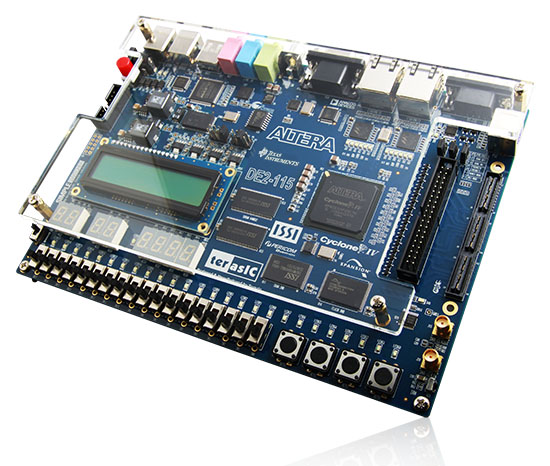Note: this is an information page, the course is given through LiU's e-learning system lisam
TSIU03 - System Design
TSIU03 is an introductory course to circuit design using VHDL. The general description of the course can be found in the syllabus.
The course is intended for bachelor students with no previous knowledge in VHDL. Students are however supposed to have previous knowledge in switching theory and it is highly recommended to have studied circuit design before.
Master students (specially those that have knowledge in circuit design and programming skills) should preferably apply for the more advanced course Design of Digital Systems (TSTE12). Due to a partial overlap between the content in TSIU03 and TSTE12, it is only allowed to register for one of these courses.
Course Aim
The course includes methods and tools for the design and implementation of electronic systems using VLSI techologies. The design methods aim at reducing the design time and guarantee correct designs as well as ensuring that performance requirements are met.
The target platform is the FPGA development board DE2-115. You will learn how to configure the FPGA to perform sound manipulation and video generation, among other.
The tools you will learn to use is mainly Mentor’s Modelsim (for simulation), and Intels Quartus II (for synthesis, i.e. compiling VHDL code to the bitstream used by the FPGA).

Course Content
The course is organized in lectures, labs and a finally a project. You will also have some assignment works.
Lectures
During ten lectures, you will learn about VHDL, FPGAs, signal processing etc.
Assignments
After some of the lectures, you will get assignments (“home work”), that will help you reflect upon what was told during the lectures. The tasks in the assignments is developed to be relevant in the final project.
Laboratory Work
There are four labs in the course.
The Lab1 - Introduction, is mainly a tutorial, where you will learn how to use the tools.
In Lab2 - Keyboard, you will learn how to decode the PS/2 protocol, to read keystrokes from a keyboard.
In Lab3 - VGA, you will generate control signals for a VGA screen. There is an image stored in an SRAM, that you need to continuously read and send to the VGA. As a part of this, you will learn about pipelining.
In Lab4 - Audio, you will produce a hardware driver for “talking to” an external audio chip, via the protocol I2S. For this, you need to learn about the concept of samples, and how to translate them between bit serial and parallel. When done, you will enjoy the speakers saying “beep” and “boop”.
Project
The main part of the course is the project. In a project group with around six students, you will create a complete sound manipulating system.
The system shall be able to read sound from a sound source, and send it to a pair of speakers. On the way, it can modify the volume, and balance. Settings, such as volume, are read from a keyboard. The settings are displayed on the VGA screen.
Apart from this, there are different extensions to select between:
-
Digital Oscilloscope - Show the shape of the sound signal on the VGA screen.
-
Signal Level Indication - Show the power level of the signal on the VGA screen.
-
Echo - Make some kind of echo functionality.
-
Equalizer - Divide the sound signal into frequency bands, manipulate each band individually.
-
Own idea? - You are welcome to suggest something else instead.
Course Material
All material, such as lecture slides, lab compendium etc, are provided via the platform Lisam, unless otherwise noted.
There are also two course books:
-
“VHDL for Logic Synthesis”, Andrew Rushton. John Wiley & Sons, 2011 (3rd edition). ISBN-13: 978-0470688472. Links: LIU Library, Online Version.
-
“Digital Design: An Embedded Systems Approach Using VHDL”, Peter J. Ashenden. Morgan Kaufmann, 2007. ISBN-13: 978-0123695284. Links: LIU Library, Online Version.
Note: You might need to be within the university network in order to access those.
The students can have access to the books in different ways:
- The LIU library has bought two printed copies of each book that the students can borrow.
- The books are available online for all the students from the web page of the LIU library with unlimited access.
- Thus, it is not needed to buy the books. Only if you like any of them and want to get a printed copy for the future, you can buy it. The books can be purchased at Bokad (in Kårallen).
Teachers
- Kent Palmkvist: Examiner, lectures
- Petter Källström: Labs, project, assignments, misc
- Narges Mohammadi: Labs, project
- Mikael Henriksson: Labs, project